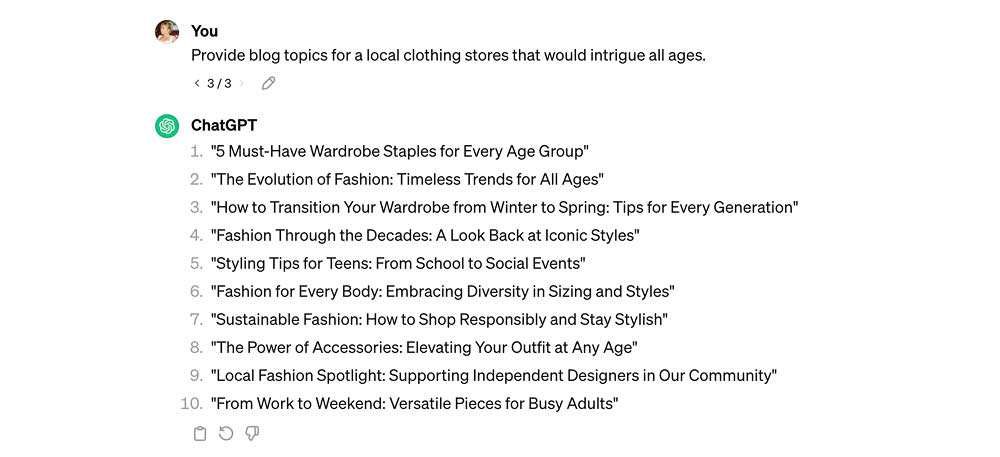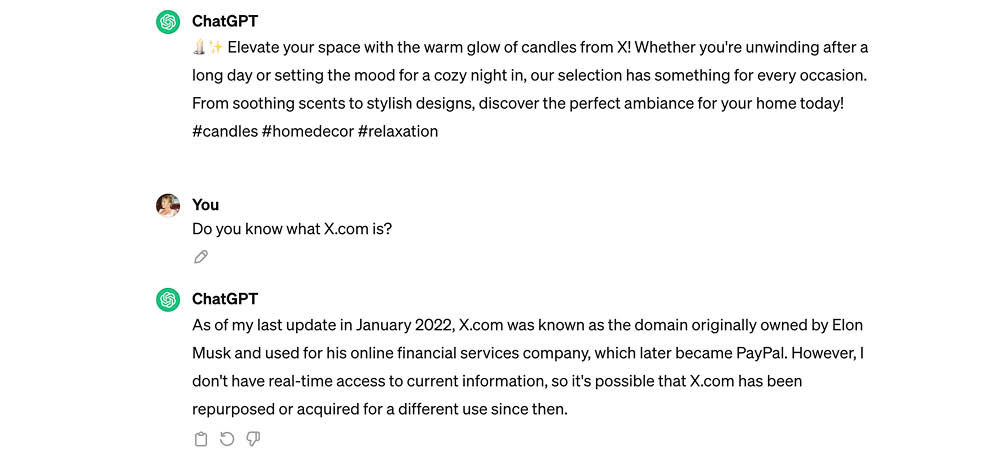May 6, 2024
Hannah Burke
Social MediaContent MarketingDigital Marketing
6 Tips For Using ChatGPT To Enhance Your Digital Marketing Efforts
In the dynamic landscape of digital marketing, ChatGPT has emerged as a revolutionary tool, captivating the marketing industry with its ability to understand and generate human-like responses. As marketers eagerly explore the potential of this futuristic language model, our experts at Blue Compass embarked on a journey to unravel the enigma that is ChatGPT, delving into its applications, best practices and intricacies of the platform. We experimented with the easily accessible free version to ensure our insights allow professionals to gain confidence using the platform for everyday tasks. We’re happy to report there are several ways to use this tool without having to spend a dime!
So, What Is ChatGPT?
Developed by OpenAI and launched in November 2022, ChatGPT is a cutting-edge language model that uses artificial intelligence (AI) and natural language processing to generate human-like conversations. Essentially a chat box, users are able to prompt the platform by asking questions or making requests, and the platform replies with contextually relevant responses. For example, if you ask for blog topics, it delivers!

This advanced technology represents a leap forward in language processing. As innovations in the field continue to unfold, the applications of ChatGPT in the digital marketing space will also continue to evolve in ways we have yet to imagine. At Blue Compass, we’re excited about the potential of ChatGPT for marketing and have proactively integrated this AI application into our workflow.
How Can I Use ChatGPT For Marketing?
Following ChatGPT best practices can assist marketers in generating creative and engaging copy, optimizing content for search engines, personalizing communication for target audiences and more. With its ability to relieve the pressure of creative exploration and ease the burden of repetitive tasks, ChatGPT can be a valuable ally for marketing teams. Especially when writer’s block has plagued your mind, having a resource available to assist you in putting your thoughts into words is a welcomed support. Here are 10 ways we’re using ChatGPT for marketing efficiencies:
From ideation assistance to facilitating content development and more, the possibilities for leveraging ChatGPT in digital marketing are vast. However, amidst the excitement, it's crucial to acknowledge the pivotal role that humans play in shaping the success of these diverse applications. While ChatGPT brings efficiency and creativity to the table, human expertise remains indispensable when it comes to providing strategic direction, understanding nuanced contexts and ensuring ethical approaches. Utilizing ChatGPT effectively does require a bit of patience, persistence and prompt fine-tuning!
- Topic and market research - Conduct research on topics you aren’t familiar with in a conversational way to get industry insights and target market preferences. Simplify complex topics for clearer communication with your audience.
- Idea generation - Turn to ChatGPT during your next brainstorming session to generate creative ideas for search engine marketing (SEM) and social media campaigns, blog topics, brand voice and more. Tailor your prompt to elicit a response that inspires a light bulb moment.
- Social media captions - Craft or fine-tune organic and paid social media content that will resonate with your intended audience. Differentiate content across platforms to inspire the right crowds and reach the right people.
- Hashtag development - Create effective and trending hashtags that enhance the discoverability of your social media posts and campaigns. #YesPlease
- Long-content summaries - Short on time? Summarize lengthy articles, reports or blog posts using ChatGPT so you’re prepared with talking points before an unexpected meeting or looming deadline.
- A/B test multiple copy variations - Generate diverse copy variations for campaigns to ensure a range of options for A/B testing and optimization. Creating distinct verbiage to gain audience insights is as easy as ABC with ChatGPT’s extensive vocabulary.
- Email subject lines - Improve your email marketing strategy by developing attention-grabbing subject lines with ChatGPT. Increase open rates and click-throughs with concise, catchy subjects tailored to capture your audience’s attention.
- Content ideation - Create high-quality outlines and copy suggestions for various platforms, saving time in the content creation process. Use ChatGPT to clear up a brain block and get back on track if you’re feeling stuck.
- Image inspiration - Collaborate with ChatGPT for visual content ideas that align your message with your marketing goals. ChatGPT points you in the right direction so you can execute eye-catching visuals and add pizzazz to your projects.
- Tone of voice - Develop and test various tones of voice for your campaigns by giving ChatGPT a persona to replicate. Create consistent messaging tailored to your customer base.
Six Tried-And-True ChatGPT Best Practices
To help you get the most out of ChatGPT for marketing processes, we’ve tested and compiled proven tips for using ChatGPT in your own efforts. After extensively using the platform and trying out a multitude of prompts, our team has identified the following ChatGPT best practices to help optimize your experience:
1. Be Clear & Specific
When prompting ChatGPT for marketing purposes, it’s important to clearly state your questions and requests. The more specific you are, the better ChatGPT is able to tailor its responses to your needs.
For example: when creating social media copy, include the platform you’re requesting a caption for. It will cater the copy and tone for the platform. Better yet: include the character limit to keep it concise and to the point.
2. Keep It Simple
Don't anticipate ChatGPT delivering a top-notch response right off the bat. Based on our observations, if your initial prompt contains excessive information or numerous requests, ChatGPT may struggle to adhere to all the specified parameters.
For instance, if you request a 200-character social media caption for LinkedIn with three hashtags and no emojis, you might end up with a 230-character caption, two hashtags and an emoji. To enhance the accuracy of the response, we suggest presenting a single request in the initial prompt and considering follow-ups to continually refine ChatGPT's output. This approach not only brings you closer to the desired caption or end product but also aids ChatGPT in better comprehending and addressing each request.
3. Stay On Subject, Or Start A New Chat
It’s also good to know that ChatGPT compounds prompts and has a tendency to get confused and distracted amidst subject or request changes. If you find yourself starting a new request in a chat that includes an initial prompt that conflicts with your new request, we recommend clicking the Notepad icon and starting a new chat. Just as a human might get confused by conflicting requests in one conversation, ChatGPT does, too.
4. Use Natural & Consistent Language
ChatGPT doesn’t require you to use any special codes or commands (unless you're asking for a specific tool like Python code execution). Simply type your questions or requests as you would naturally. However, be consistent in the language you use. If you reference something by its full name and an abbreviation within the same request or chat—say, “responsive search ads” versus “RSA,” for example—ChatGPT could easily get confused. Our team found the most success when prompts were short, specific and consistent.
5. Fact-Check Your Results
For a multitude of reasons, including serious ethical considerations, we don’t recommend copying your ChatGPT results word-for-word. As innovative as AI is, remember that ChatGPT is pulling information from millions of web pages across the internet—web pages created by humans. Humans are prone to error and often publish content with inaccurate information and biases, whether they are aware of it or not. Fact-check any information ChatGPT provides you to ensure legitimacy and accuracy.
While ChatGPT serves as an invaluable tool, the indispensable role of humans in comprehending context, depth, nuance and more remains evident. AI technology, as remarkable as it is, currently falls short of completely replicating a brand's voice or authentically reflecting a business' values. However, this doesn't discount the significant potential it holds. Consider ChatGPT as a launching pad to generate ideas, quickly grasp unfamiliar subjects and organize your thoughts.
6. Be Aware Of Limitations
Be cautious the free version of ChatGPT is only up-to-date on current events and knowledge up to January 2022 (as of the publishing of this article). If you're looking for the freshest info, it's best to fact-check with other sources or upgrade to ChatGPT’s paid version. However, even the advanced version of ChatGPT is only caught up through April 2023. For instance, ChatGPT would not be helpful to write a social media post for X. Since Twitter rebranded into X in July of 2023, ChatGPT is still behind the times and doesn’t recognize references to X. As humans, we all know Twitter was so last year!

Contact Our Experts To Gain Additional Tips For Using ChatGPT In Digital Marketing
As the industry evolves to integrate ChatGPT for digital marketing, remember human thoughts remain unmatched. Simply use the platform to enhance your ideas, not replace them! If you’re curious about using AI or other marketing tools, reach out to our team for personalized digital marketing insights and tips for using ChatGPT to elevate your marketing initiatives.